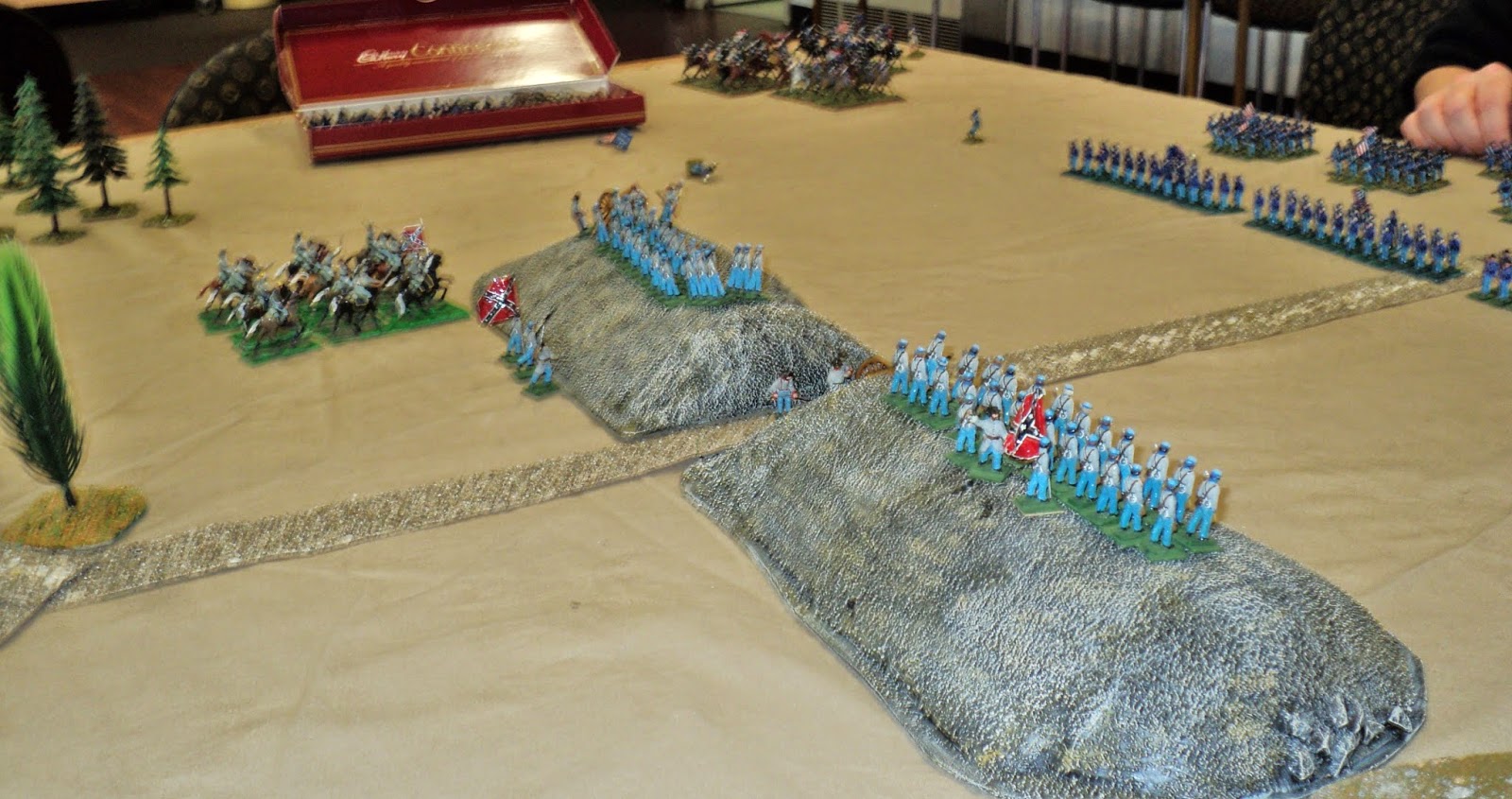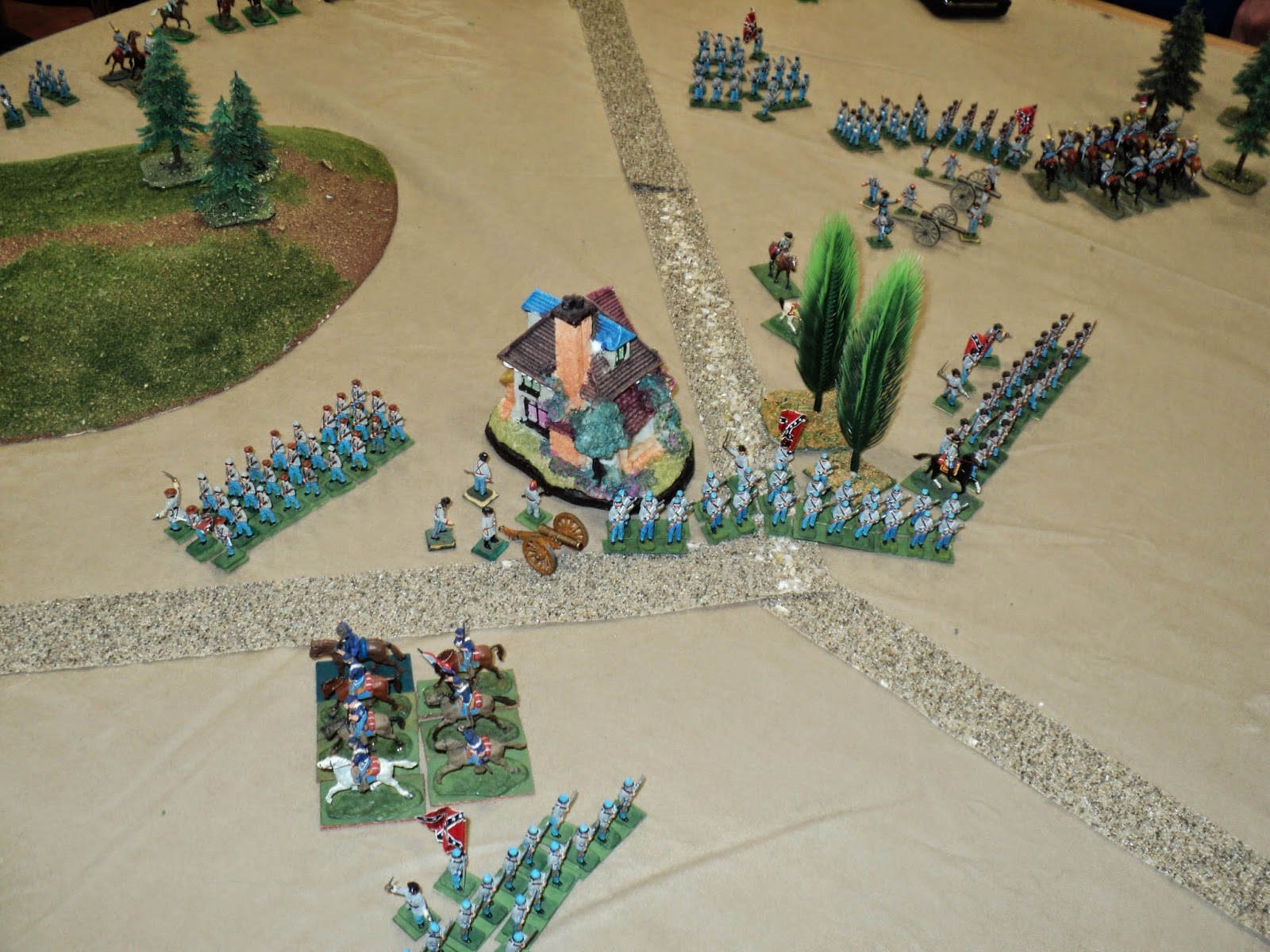Just over a week ago, I had a return match with Andy, following my close-fought victory of the weekend before. This time it was a Napoleonic game, using Mark's figures and the rule set Lasalle, one of Sam Mustafa's earlier Napoleonic rule sets. In what follows, I have let the pictures tell the story. My apologies for the woeful photography here and there - they really don't do justice to Mark's superb figures. My hands aren't as steady as once they were, so I'll have to start using some kind of support, that's clear. Before continuing, you might want to check out Mark's blog, Chasseur, for his account of the action. His pictures are by and large better than mine, too.
(Before continuing I must thank the seven who have begun following this blog since the New Year. I will make a more formal acknowledgement next time).
 |
| The French line, looking west to east. |
On Table:
Infantry Brigade: 6 x 24-figure battalions (144 figures);
Foot Battery: 4 cannon;
Light Cavalry Brigade: 4 x 8-figure units (squadrons? regiments?) (32 figures);
Horse battery: 3 cannon
Arriving from off table by random die roll:
Cuirassier Brigade: 2 x 12-figure units (24 figures)
Horse Battery: 3 cannon
Austrian Army:
On Table:
Line Infantry Brigade: 4 x 36-figure, plus 2 x 24-figure battalions (192 figures);
Landwehr Infantry Brigade: 6 x 24-figure battalions (144 figures);
2 x Foot Batteries: each 4 cannon.
Arriving from off table by random roll:
Cuirssier Brigade: 2 x 12-figure units (24 figures);
Horse artillery: 3 cannon
 |
| Austrian Landwehr drawn up on the Austrian left flank. |
As you will appreciate, the Austrians outnumbered the French by a considerable margin, and had a cannon extra as well. But against that, the Landwehr proved to be very brittle troops, and the French regular light horse proved an annoyance as well.
 |
| Austrian regular infantry. I was relying on those big battalions for the decisive punch... |
 |
| French light horse taking one look at the advancing Austrian line, before making off... |
 |
| More general view of the Austrian right flank. |
 |
| The Landwehr were supposed to carry out a pinning attack upon the French left in order to hold it in place. That plan proved a dismal failure. |
 |
| Right from the start, French infantry peeled off from their right flank to deal with the threatened left. |
 |
| Austrian artillery overseen by the Austrian commander, Feldmarschall-Leutnant Kuekenhertz |
 |
| Could the Landwehr close the range betimes to pin down the French right? |
 |
| Another view of the Landwehr in serried array. |
 |
| Général de Division Andre Poulecoeur hurrying his troops eastwards... |
 |
| Thinking hard... Can that Austrian juggernaut be stopped? |
 |
| Two French cuirassier units hit the lone landwehr battalion. Though the foot formed square betimes, it did them no good. No good at all... |
 |
| Boots, boots, boots, boots... |
 |
| The French light horse making nuisances of themselves. I really should have kept a better flank guard than I did.... |
 |
| The French right has been effectively stripped of its infantry... |
 |
| The first wave of the assault goes in! |
 |
| Forming square under the muzzles of the enemy artillery was not going to end happily... |
 |
| The Austrian high water mark on their right centre... |
 |
| But having relaxed their guard on the right, the Austrians have allowed two units of enemy light horse into their right rear... |
 |
| ... Just as a big counterattack goes in against the woods recently captured by the Austrians. |
 |
| The pitiful remnants of the Austrian Landwehr: three units ridden down by French heavy cavalry; two more crushed by artillery. One battalion remains... isolated from its fellows... |
 |
| A rather fuzzy photo to conclude. One heavily battered Austrian battalion has departed the scene, and that defending the wooded hill, attacked front and flank, is about to collapse in rout also... |
With the collapse of two of the large Austrian battalions, together with the five long since departed landwehr units, the Austrian army morale broke, and the survivors withdrew from the battlefield. We had handed out a few licks of our own - two French battalions had also broken - but there was no disguising the action as other than a decisive French victory. Congratulation General Poulecoeur Andy!







.jpg)
















